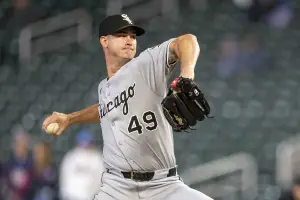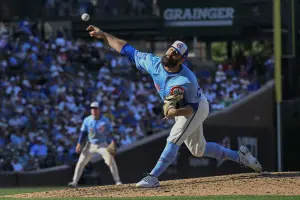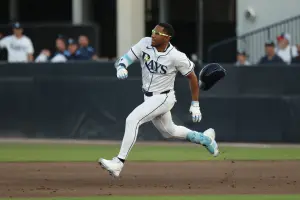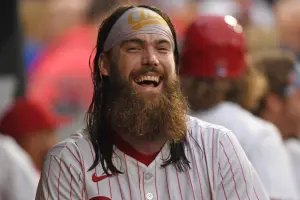
(*) PT TOMORROW: NL East—Going through a Voth phase
The Nationals have one of the most accomplished and feared starting rotations in baseball. Max Scherzer (RHP, WAS), Stephen Strasburg (RHP, WAS), and Patrick Corbin (LHP, WAS) are arguably the best 1-2-3 punch out there. Behind them, Aníbal Sánchez (RHP, WAS) produced another solid season in 2019, posting 11 W, 3.85 ERA, 1.27 WHIP, 58 BB, 134 K in 166 IP; his spot seems secure for now. Who’s competing for the fifth spot?
One player who has caught the attention of a large number of touts is Austin Voth (RHP, WAS). Returning readers will recall our own cautiously optimitic assessment in this space of his chances as he was called up to the team in 2019. He performed well, especially as an unheralded arm: 3.30 ERA, 1.05 WHIP, 9.1 Dom, 2.7 Ctl in 44 IP. Somewhat preferential H% (26%) and S% (73%) rates resulted in a 4.21 xERA and one should expect that WHIP to rise accordingly given more average rates. But there’s enough here to merit our attention, starting in general with his excellent 104 BPV. More specifically, his 13% SwK is comfortably above league average and supports his healthy strikeout rate. At 92.8 mph, the fastball doesn’t stand out (although it did record a positive PVal according to Fangraphs), but what does is that he added a tick-and-a-half to it from 2018 to 2019.
Voth’s main competition is Joe Ross (RHP, WAS), who finally came back from 2017 Tommy John surgery in 2019, splitting his time between Triple-A and WAS. Ross had his velocity back (94.1 mph), which was encouraging, but little else worked particularly en route to 4 W, 5.48 ERA, 1.67 WHIP, 4.6 Ctl, 8.0 Dom. Pitchers often struggle to reestablish their control after TJS, but we’ll have to see significant improvement in that area before we can recommend him.
One last thing to note: Aníbal Sánchez did indeed have a decent year on the surface, but his underlying metrics (5.15 xERA, 1.41 xWHIP) suggest that he’d be hard-pressed to repeat those category stats. At 36, and with softening skills, the veteran hurler will be walking a tightrope. The Nationals may have two vancacies at the back of their rotation before long.
Get the 2020 season started off on the right foot! Access articles like these and our diverse range of tools with a subscription to BaseballHQ.com. Winning. Fantasy Baseball. Insight.
The Marlins had a little scare when Brian Anderson (3B/OF, MIA) had to exit a game after being hit on the left hand with a pitch—the same hand he injured last August when he broke his pinkie and missed the rest of the season. Fortunately, it appears that he dodged serious injury, as the pitch hit a protective pad on his hand. But let’s use the event as a springboard to dive into 3B depth in MIA.
Anderson was enjoying a promising season of growth before the injury. The 2020 Baseball Forecaster notes his surging xHR, xPX, and xBA, and his HctX climbed to 15% above league average (115). He was even awarded one of the book’s coveted “UP” tags, with 30 HR and a .280 BA seen as possibilities given the trajectory of his skills.
The team has shuttled Anderson between 3B and OF since his debut, but the plan to move him back to 3B was solidified after Corey Dickerson (OF, MIA) signed in the offseason and Martín Prado (3B, FA) announced his retirement. Anderson was excellent defensively at 3B in 2019 (11.2 UZR/150). Of course, Garrett Cooper (OF, MIA), who’s currently slated to man RF, has a long injury history, so who’s to say if manager Don Mattingly doesn’t move Anderson back to RF out of necessity at some point during the season. Perhaps a combination of Cooper’s spotty health record and Anderson’s versatility and competency is fueling BHQ’s projected playing time for Anderson, who currently has a 50% PT share in OF and 35% at 3B.
Jon Berti (3B/SS/OF, MIA), who was a late-season fantasy MVP for many roto GMs last year (.273/.348/.406, 52 R, 6 HR, 24 RBI, 17 SB in 256 AB) currently has a 40% projected share of 3B PT after playing 20 G there in ’19. Berti’s speed is real (147 RSPD, 130 SPD), but his lack of pop (90 HctX, 59 xPX), so-so contact (71%), and age (30) all cap his ceiling and fantasy value. Miguel Rojas (SS, MIA) is mostly expected to man short, but he has played 98 G at the position in his MLB career, including 39 G in 2018 for MIA.
Robinson Canó (2B, NYM) is entering the season as the starting second baseman for the Metropolitans, but it doesn’t take too much sleuthing to notice that he hasn’t played a full season since 2017. At 37, coming off leg injuries that cost him 52 days on the IL in 2019, what can we expect from Cano and how will the Mets fill in for him?
Cano has been a very good hitter for a very long time. Quickly scanning his historical stats, we can see that he’s never had a HctX score under 108—though it’s definitely worth noting that 2019 number represented a career low. His ct% has been remarkable stable over the years—although, again, his career low 82% mark came in, you guessed it, 2019. Okay, let’s save some time… here are all the stats that were career-low marks for Cano in 2019: BA (.256), H% (28%), BPV (39), R$ (4), and the aforementioned HctX and ct%. Basically, with the long injury-related absence and declining skills, Cano showed himself to be exactly what many Mets fans and analysts feared he would be: a potential Hall of Famer who could quickly descend down the steep part of the aging curve slope.
Even if Cano enjoys a moderate bounceback season skills-wise, the issue of his playing time will become increasingly problematic. Now 37, it's just not likely that he can shoulder a true full-time PT share at a physically-demanding infield position. BHQ currently projects Cano to have a 75% share of 2B PT, and while that’s possible, it’s also not something he’s done since he was a spry and idealistic young man of 34.
The obvious candidate to fill in at 2B is Jeff McNeil (INF/OF, NYM). The plan for now is to have McNeil play mostly at 3B, but he could easily slide over to 2B, where he played 37 G in 2019.
The less obvious candidate to fill in at 2B is Jed Lowrie (2B, NYM), who played 136 G at the position with OAK in 2018 and split his time between 2B and 3B during his minor league rehab assignments with the Mets in 2019. The problem is that little is known—still!—of Lowrie’s health status and availability. He came into camp wearing a large leg brace, and as of Feb 24 was still not ready to play in spring games. Mets manager Luis Rojas hasn't indicated whether they expect a lengthy absence or not. Lowrie’s outlook remains largely shrouded in mystery.
Spring training is a time for excitement and overreaction, when every adjustment is a potential career-changer, and every injury a possible season-ender. On that note, Adam Haseley (OF, PHI) exited the game on Feb 25 after injuring his face while diving for a ball in the outfield. He appeared to have a cut on his forehead near his eye, but left the field under his own power. The severity of the injury is not yet known, although the hope, of course, is that it’s nothing too serious, but we’ll go ahead and use this incident to discuss the PHI options in center.
Haseley had a mostly unspectacular rookie season in 2019, posting a .266/.324/.396 line with 30 R, 6 HR, 26 RBI, 4 SB in 222 AB. His skills were a bit soft: 91 HctX, 82 PX, 53 xPX, 6% BB% 73% CT%, 0 BPV. The Forecaster notes his too many GB, struggles vLHP, and the possibility of losing PT in a platoon. This is all true based on his small sample of MLB AB, but a look at his MiLB numbers reveals that, in a similarly small sample (57 AB) v LHP in AA in ’19, Haseley had a .942 OPS. That number dropped to .697 in a tiny 22 AB sample in AAA before his eventual call up to PHI. Is that conclusive proof that Haseley can indeed hit lefties? Of course not! But perhaps we shouldn’t close the book on the 24-year-old’s potential for full-time PT just yet.
Haseley’s right-handed caddy is Roman Quinn (OF, PHI), whose main problem has been staying healthy. The 27-year-old has missed 181 days on the IL over the past three seasons, fully supporting his “F” health grade. He’s currently projected for a 40% PT share in the OF and 250 AB—his season high is 131 in 2018. If Quinn could remain on the field long enough to use his blazing speed on the basepaths—he’s posted RSPD scored of 158, 201, and 165 over the past three seasons—he could, according to the Forecaster, steal up to 30 bases in as few as 300 AB.
Normally, there wouldn’t be too much to discuss regarding first base depth in Atlanta, as Freddie Freeman (1B, ATL) has been one of the steadiest and most productive players at the position in all of baseball. But with news that Freeman is sitting out the next few days of spring training with a sore elbow, it might be worth our while to quickly review what’s going on with the star slugger and which players are the potential understudies who could step into the role if needed.
Freeman had elbow surgery in October to remove two bone spurs and three bone fragments. According to Dave O’Brien of The Athletic, the doctor told Freeman that the elbow was in such bad shape prior to surgery that “he didn’t know how he played through it.” But play he did, and rather well at that: .295/,389/.549 with 113 R, 38 HR, 121 RBI, 6 SB, 128 HctX, 133 xPX, returning $30 5x5 value. The runs, homers, and RBI represented career highs.
In spite of the stellar numbers, Freeman was apparently suffering through the bum elbow. After the surgery, the first baseman declared that he was pain-free for the first time in nine years, which sounds like a very good thing indeed. He had no limitations entering camp, but now he’s dealing with inflammation.
Braves manager Brian Snitker explaned that “the doctor said it’s not an uncommon thing” and that he’d give Freeman the next few days off. Yonder Alonso (1B, ATL) replaced Freeman in the lineup during his first day out. Alonso came out of nowhere with a revamped swing in 2017 and became the poster child for the launch angle revolution, shattering his previous season high for homers (9) with 28. He followed that up with a decent 2018, but cratered in 2019 to the tune of .199/.296/.346 with 10 HR in 292 AB between CHW/COL. In his player capsule, the Forecaster projected “average production going forward, if anyone gives him playing time.” So what is average production for Alonso? Probably something along the lines of his 2018, with its league average 99 PX/105 xPX, .243 xBA, and 106 HctX. Basically, he’d be a capable if unspectacular fill-in.
Another name that might get scribbled into the lineup over the next week is Travis D Arnaud (C/1B, ATL), who played 21 G at 1B in 2019. He has a nice year after bouncing around a bit (.251/.312/.433 with 16 HR, 52 R, 69 RBI in 351 AB) and the prospect of him getting some extra reps while filling it at first has made him a popular later-round C pick. With Freeman ailing, d’Arnaud could get another slight bump.
If Freeman’s elbow issue lingers, make note of whether Austin Riley (3B/OF, ATL) gets any looks at 1B. Adam Duvall (OF, ATL) played both corners in the minors but has only totaled 43 G at 1B in MLB.








